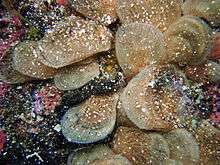Isognomon
(For the tree oyster mushroom, see Pleurotus ostreatus.)
| Isognomon | |
|---|---|
 | |
| Live Isognomon sp. under a rock in Kona District, Hawaii | |
| Scientific classification | |
| Kingdom: | Animalia |
| Phylum: | Mollusca |
| Class: | Bivalvia |
| Order: | Pterioida |
| Family: | Pteriidae |
| Genus: | Isognomon Lightfoot, 1786 |
| Type species | |
| Ostrea perna Linnaeus, 1767 | |
| species | |
|
See text. | |
| Synonyms | |
| |
Isognomon is a genus of marine bivalve mollusks which is related to the pearl oysters.[1]
Isognomon is known in the fossil record from the Permian period to the Quaternary period (age range: 254.0 to 0.012 millions years ago). Fossils of species within this genus have been found all over the world.[2]
Taxonomy
This genus was formerly placed in the family Isognomonidae, however molecular phylogeny studies have shown that these tree oysters belong in the family Pteriidae.[3]
Description
These oysters grow to be about 4.75 inches (12.1 cm) in overall length, producing a highly irregular shell with a blue-gray and often heavily encrusted exterior but a smooth and pearly white interior. They use their byssus to completely immobilize themselves to the roots of mangrove trees, corals, and other substrates.[4] It is because of the preference for mangroves that these are sometimes called tree oysters[5]
Species
- Isognomon alatus (Gmelin, 1791) — Flat tree-oyster
- Isognomon albisoror (Iredale, 1939)
- Isognomon australica (Reeve, 1858)
- Isognomon bicolor (C.B. Adams, 1845)
- Isognomon californicum (Conrad, 1837)
- Isognomon dunkeri (P. Fischer, 1881)
- Isognomon ephippium (Linnaeus, 1758)
- Isognomon incisum (Conrad, 1837)
- Isognomon isognomum (Linnaeus, 1758)
- Isognomon janus Carpenter, 1857
- Isognomon legumen (Gmelin, 1791)
- Isognomon nucleus (Lamarck, 1819)
- Isognomon perna (Linnaeus, 1767)
- Isognomon radiatus (Anton, 1838) — Lister's tree oyster
- Isognomon recognitus (Mabille, 1895)
- Isognomon vulselloides Macsotay & Campos, 2001
Extinct species
Extinct species within this genus include:[2]
- †Isognomon gariesensis Kensley and Pether 1986
- †Isognomon gaudichaudi d'Orbigny 1842
- †Isognomon isognomoides Stahl 1824
- †Isognomon isognomon Linnaeus 1758
- †Isognomon isognomonoides Stahl 1824
- †Isognomon legumen Gmelin 1790
- †Isognomon maxillatus Lamarck 1819
- †Isognomon nucleus Lamarck 1819
- †Isognomon quadrisulcata Ihering 1897
- †Isognomon valvanoi Rossi de Garcia and Levy 1977
- Species brought into synonymy
- Isognomon acutirostris (Dunker, 1869): synonym of Isognomon nucleus (Lamarck, 1819)
- Isognomon anomioides (Reeve, 1858): synonym of Isognomon australica (Reeve, 1858)
- Isognomon aviculare (Lamarck, 1819): synonym of Isognomon isognomum (Linnaeus, 1758)
- Isognomon brevirostre Link, 1807: synonym of Isognomon isognomum (Linnaeus, 1758)
- Isognomon dentifer (Krauss, 1848): synonym of Isognomon nucleus (Lamarck, 1819)
- Isognomon isognomon (Linnaeus, 1758): synonym of Isognomon isognomum (Linnaeus, 1758)
- Isognomon roberti Koch, 1953: synonym of Isognomon perna (Linnaeus, 1767)
- Isognomon rude (Reeve, 1858): synonym of Isognomon isognomum (Linnaeus, 1758)
- Isognomon rupella (Dufo, 1840): synonym of Isognomon nucleus (Lamarck, 1819)
- Isognomon sulcatum Lamarck: synonym of Isognomon perna (Linnaeus, 1767)
- Isognomon vulsella (Lamarck, 1819): synonym of Isognomon legumen (Gmelin, 1791)
References
- ↑ Isognomon Lightfoot, 1786. Retrieved through: World Register of Marine Species on 12 March 2011.
- 1 2 Fossilworks
- ↑ Temkin, I. (2010) Molecular phylogeny of pearl oysters and their relatives (Mollusca, Bivalvia, Pterioidea), BMC Evolutionary Biology 10:342
- ↑ Arthur Peter Hoblyn Oliver (2004). Guide to Seashells of the World. Firefly. p. 300. ISBN 978-1-55297-943-3.
- ↑ Papuaweb Archived 2012-10-17 at the Wayback Machine.
- Gofas, S.; Le Renard, J.; Bouchet, P. (2001). Mollusca, in: Costello, M.J. et al. (Ed.) (2001). European register of marine species: a check-list of the marine species in Europe and a bibliography of guides to their identification. Collection Patrimoines Naturels, 50: pp. 180–213
- Huber M. (2010) Compendium of bivalves. A full-color guide to 3,300 of the world’s marine bivalves. A status on Bivalvia after 250 years of research. Hackenheim: ConchBooks. 901 pp., 1 CD-ROM
- Coan E.V. & Valentich-Scott P. (2012) Bivalve seashells of tropical West America. Marine bivalve mollusks from Baja California to northern Peru. 2 vols, 1258 pp. Santa Barbara: Santa Barbara Museum of Natural History.